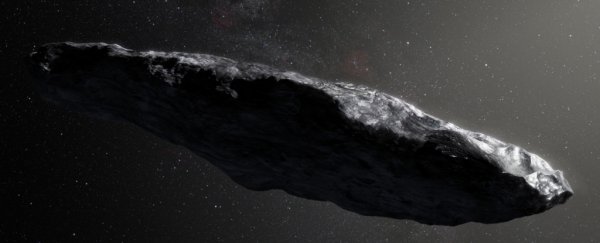The tumbling roll of the cigar-shaped 'Oumuamua could have been the result of a collision with another object.
And, according to astronomers, it's going to carry on tumbling for at least a billion years into the future, providing it doesn't crash or collide again.
The first known object to enter our Solar System from interstellar space, planetesimal 'Oumuamua has been of keen interest to astronomers since its discovery in October last year.
It's very peculiar, a shape never before seen in an object of its type - around eight times longer than it is wide.
There's also some uncertainty over what it actually is: while it looks like an organic-rich rocky asteroid, it could also have an icy core, like a comet.
As it travels through space - which it has likely been doing for hundreds of millions of years - it's also moving in a strange way, tumbling end over end.
It was the exact nature of the unusual roll that a team from Queen's University Belfast, led by Wes Fraser, wanted to figure out.
By studying the object's brightness from all the optical photometry to date, the team worked out that the object is tumbling chaotically.
This sort of movement has been seen in Solar System objects that are much smaller and more traditionally asteroid-shaped than 'Oumuamua, and it can be caused by a number of different factors.
Amongst the potential causes are tidal torques caused by planetary close encounters; cometary activity; and something called the Yarkovsky-O'Keefe-Radzievskii-Paddack effect, involving solar radiation and internal thermal activity.
But for 'Oumuamua, one cause seems more likely than these others.
"At some point or another it's been in a collision," Fraser told the BBC.
'Oumuamua is already on its way out of the Solar System, due to reach Jupiter's orbit in May of this year and Saturn's in January 2019, but it's going to continue to tumble long after it leaves our neighbourhood, the researchers said.
But it won't tumble forever. Eventually, the internal strains and stresses caused by the motion will bring it to a halt.
The team has calculated how long that "eventually" might be for both a rocky asteroid and an icy comet (since we're not sure which it is), and concluded that, whichever it is, it's going to be at least a billion years before its tumble stops.
As for when it started tumbling, that's a bit harder to say, although the researchers believe it most likely happened in 'Oumuamua's own solar system.
"It's hard to know if it was during planet formation or after the planet formation process," Fraser said.
"Certainly, more collisions happen while planets are growing than afterwards, so that's a very good guess. But unfortunately we can't get a high-resolution image of this thing to see what kind of crater is on it that might be attributed to the collision that caused it to start tumbling."
The research has been published in Nature Astronomy.
